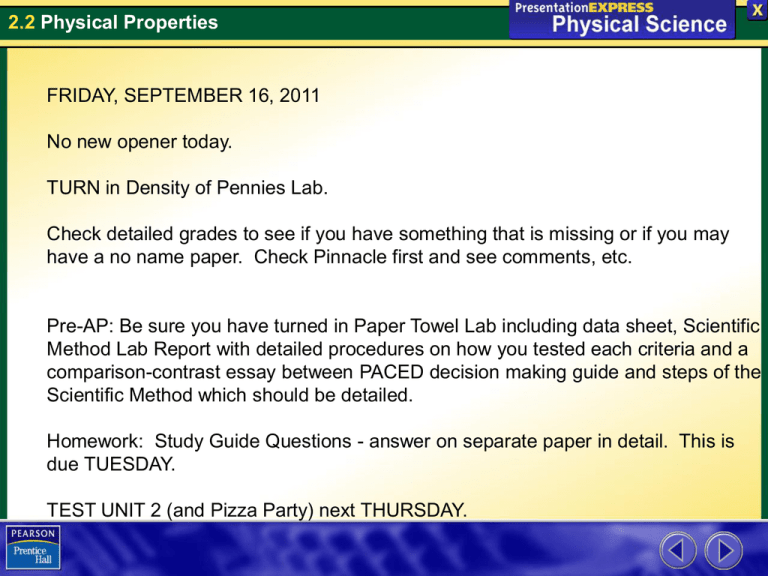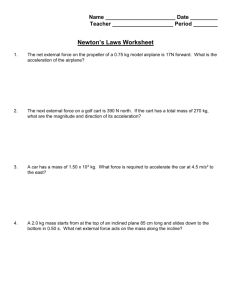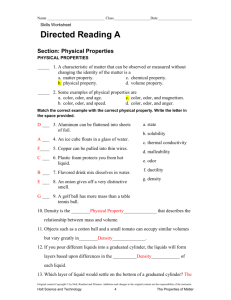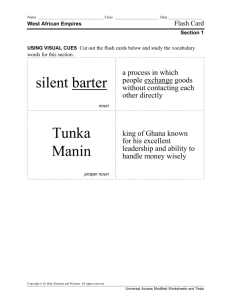
2.2 Physical Properties
FRIDAY, SEPTEMBER 16, 2011
No new opener today.
TURN in Density of Pennies Lab.
Check detailed grades to see if you have something that is missing or if you may
have a no name paper. Check Pinnacle first and see comments, etc.
Pre-AP: Be sure you have turned in Paper Towel Lab including data sheet, Scientific
Method Lab Report with detailed procedures on how you tested each criteria and a
comparison-contrast essay between PACED decision making guide and steps of the
Scientific Method which should be detailed.
Homework: Study Guide Questions - answer on separate paper in detail. This is
due TUESDAY.
TEST UNIT 2 (and Pizza Party) next THURSDAY.
2.3 Chemical Properties
How would you describe
these candles? Color,
hardness, and density
are physical properties
that you can use in the
description. You can also
say that the candles are
burning. The ability to
burn is not a physical
property. As a candle
burns, new substances
form.
Chapter 2
Section 2 Properties of Matter
Comparing Physical and Chemical Properties
Click below to watch the Visual Concept.
http://my.hrw.com/sh/hk6_0030
Visual Concept
390966/student/ch02/sec02/vc0
0/hk602_02_v00fs.htm
Chapter menu
Resources
Copyright © by Holt, Rinehart and Winston. All rights reserved.
2.3 Chemical Properties
Observing Chemical Properties
When can chemical properties be observed?
Note the
audio comes
in early but
goes with
later slide ...
QuickTime™ and a
decompressor
are needed to see this picture.
Be sure to
watch gummy
bear explode.
You can
forward the
video with
the slide
past the
man you
already
heard but
do watch
the clips
and read
the
notations.
2.3 Chemical Properties
Observing Chemical Properties
As a candle burns, its compounds
combine with oxygen in the air to form
water and carbon dioxide.
A chemical property is any ability to
produce a change in the composition of
matter. Flammability and reactivity are
two examples of chemical properties.
2.3 Chemical Properties
Observing Chemical Properties
Chemical properties can be observed only
when the substances in a sample of matter
are changing into different substances.
Chapter 2
Reactivity
LISTEN FOR AUDIO/VISUAL after you
click arrow or space bar.
QuickTime™ and a
Sorenson Video 3 decompressor
are needed to see this picture.
Watch
Reactions.
Chapter menu
Resources
Copyright © by Holt, Rinehart and Winston. All rights reserved.
2.3 Chemical Properties
Observing Chemical Properties
Flammability
Materials that burn can be used as fuel.
Flammability is a material’s ability to burn in the
presence of oxygen. (Example: paper, gasoline)
Reactivity
The property that describes how readily a substance
combines chemically with other substances is
reactivity. Ex. oxygen reacts with most
substances such as iron to form rust. Note the
reactivity levels from the previous slide with Na, Li,
and K with water as additional examples.
2.3 Chemical Properties
Another Example Reactivity for Chemical
Properties
Rust forms when oxygen reacts with iron and water.
Rust is a brittle, reddish-brown compound. Because
iron is highly reactive, you would not choose iron to
make jewelry or coins.
Chapter 2
Comparing Physical and Chemical Properties
• Characteristic properties help to identify and classify
substances.
• The table below compares some physical and
chemical properties.
Chapter menu
Resources
Copyright © by Holt, Rinehart and Winston. All rights reserved.
2.3 Chemical Properties
Observing Chemical Properties
Nitrogen has many uses that depend on its low
reactivity.
Researchers in Japan pump nitrogen gas into
the steel tanks that hold seawater in ships. The
nitrogen displaces the oxygen dissolved in the
water and prevents rusting.
...Childrens’ Pajamas... are now fire retardant or
flammable resistant,
Note these other words: inflammable, flammable,
non-flammable...
2.3 Chemical Properties
III. B.
A chemical change occurs when a substance reacts and
forms one or more new substances.
Examples: digestion (breaking down into new
substances), baking (rising and yeast with the production
of carbon dioxide...), burning, leaves changing colors...
Compare physical
and chemical
with the videoclip.
QuickTime™ and a
decompressor
are needed to see this picture.
2.3 Chemical Properties
Recognizing Chemical Changes
The color change in a banana peel is caused by
chemical changes that are taking place in the cells
of the banana. A chemical change occurs when a
substance reacts and forms one or more new
substances.
2.3 Chemical Properties
Recognizing Chemical Changes
What observations might indicate that a chemical
change has occurred?
Watch for differences between
physical and chemical changes.
QuickTime™ and a
decompressor
are needed to see this picture.
Three common types of evidence for a chemical
change are a change in color, the production of a
gas, and the formation of a precipitate.
2.3 Chemical Properties
Recognizing Chemical Changes
A new copper roof has a reddish color.
2.3 Chemical Properties
Recognizing Chemical Changes
A new copper roof has a reddish color.
The green patina on an old copper roof is
a mixture of copper compounds.
Chapter 2
Section 3 Changes of Matter
Chemical Changes
Chapter menu
Resources
Copyright © by Holt, Rinehart and Winston. All rights reserved.
2.3 Chemical Properties
Recognizing Chemical Changes
Production of a Gas
When you mix vinegar with baking soda, bubbles of
carbon dioxide form immediately. A similar chemical
change happens when you use baking powder as an
ingredient in a cake recipe. Bubble of carbon dioxide
expand and cause the cake to rise.
2.3 Chemical Properties
Recognizing Chemical Changes
Formation of a Precipitate
Any solid that forms and separates from a liquid mixture is
called a precipitate. Example: curdling of milk. When
an acid is added to milk, proteins in the milk undergo a
chemical change that causes them to stick together in
clumps and form a precipitate–cottage cheese.
Chapter 2
Section 3 Changes of Matter
Chemical Changes, continued
• Chemical changes form new substances that have
different properties.
• The results of a chemical change are substances
that have completely different properties from the
properties of the original substances.
Chapter menu
Resources
Copyright © by Holt, Rinehart and Winston. All rights reserved.
Chapter 2
Section 3 Changes of Matter
Chemical Changes, continued
• Chemical changes can be detected.
• Changes in physical properties can be an
indication of a chemical change.
• Examples include:
• change of color
• change of smell
• fizzing
• production of heat
• production of sound
• production of light
Chapter menu
Resources
Copyright © by Holt, Rinehart and Winston. All rights reserved.
Chapter 2
Section 3 Changes of Matter
Chemical Changes, continued
• Chemical changes cannot be reversed by physical
changes.
• Because new substances are formed in a
chemical change, the change cannot be reversed
by using physical changes.
• Many chemical changes are impossible to reverse,
for example it is impossible to “unbake” a cake.
Chapter menu
Resources
Copyright © by Holt, Rinehart and Winston. All rights reserved.
Chapter 2
Section 3 Changes of Matter
Chemical Changes, continued
• Compounds can be broken down through chemical
changes.
• Some compounds undergo chemical changes to
form elements, others break down to form simpler
substances.
Chapter menu
Resources
Copyright © by Holt, Rinehart and Winston. All rights reserved.
2.3 Chemical Properties
Is a Change Chemical or Physical?
What is the difference between chemical and
physical changes?
Chapter 2
Section 3 Changes of Matter
Comparing Physical and Chemical Changes
Click below to watch the Visual Concept.
http://my.hrw.com/sh/hk6_0030390966
Visual Concept
/student/ch02/sec02/vc05/hk602_02_v
05fs.htm
Chapter menu
Resources
Copyright © by Holt, Rinehart and Winston. All rights reserved.
2.3 Chemical Properties
Is a Change Chemical or Physical?
Are different substances present after a
change takes place? If not, then the
change is physical, not chemical.
When matter undergoes a chemical change,
the composition of the matter changes.
When matter undergoes a physical change,
the composition of the matter remains the
same.
2.3 Chemical Properties
Is a Change Chemical or Physical?
Even if you observe a color change, a gas, or a precipitate, you
cannot be sure that a chemical change has taken place. When
an iron horseshoe is heated, its color changes from gray to red,
but the iron is still iron. That means the change is physical, not
chemical.
QuickTime™ and a
decompressor
are needed to see this picture.
Rap -just for fun... - Student created...
2.3 Chemical Properties
QUICK ACTIVE ACTIVITY - Click on website Classzone...
http://www.classzone.com/books/ml_science_share/vis_sim/mem05_pg39_matter/me
m05_pg39_matter.html
See 3 items with examples of both physical and chemical changes.
2.3 Chemical Properties
Click on the following site and complete the activity Quiz...
RECORD YOUR SCORE. (THIS IS NEW SINCE THE NOTES WERE WRITTEN
UP, SO JUST WRITE IT IN SPACE ON THIS PAGE AND CIRCLE IT.)
http://vital.cs.ohiou.edu/steamwebsite/downloads/ChangeLab.swf
2.3 Chemical Properties
Assessment Questions
1. Which of these properties is a chemical property
of sulfur?
a.
b.
c.
d.
yellow
flammable
brittle
soft
2.3 Chemical Properties
Assessment Questions
1. Which of these properties is a chemical property
of sulfur?
a.
b.
c.
d.
yellow
flammable
brittle
soft
ANS: B
2.3 Chemical Properties
Assessment Questions
2. Which of the following is not a common type of
evidence for a chemical change?
a.
b.
c.
d.
a change of state
a color change
a gas produced
a precipitate formed
2.3 Chemical Properties
Assessment Questions
2. Which of the following is not a common type of
evidence for a chemical change?
a.
b.
c.
d.
a change of state
a color change
a gas produced
a precipitate formed
ANS: A
2.3 Chemical Properties
Assessment Questions
3. You can be certain that a chemical change has
occurred when
a.
b.
c.
d.
there is a visible change.
the change is irreversible.
the temperature changes.
a new substance is formed.
2.3 Chemical Properties
Assessment Questions
3. You can be certain that a chemical change has
occurred when
a.
b.
c.
d.
there is a visible change.
the change is irreversible.
the temperature changes.
a new substance is formed.
ANS: D
2.3 Chemical Properties
COMPUTER ACTIVITY
PLAY THE FOLLOWING ACTIVITY THAT I CREATED...
THIS SORTS ITEMS BY PHYSICAL PROPERTY, PHYSICAL CHANGES, CHEMICAL
PROPERTIES AND CHEMICAL CHANGES... READ CAREFULLY.
SHOW ME FINAL SCORE AND RECORD SCORE IN NOTES - GET MY INITIALS.
CLICK BELOW FOR ACTIVITY....
THEN CLICK ON START
THEN CLICK ON PROCEED...once your in the site...
http://classtools.net/widgets/dustbin_2/GnLsN.htm
2.3 Chemical Properties
CLICK ON THE FOLLOWING SITE AND TAKE THE 10 POINT QUIZ.
You may enter just your first name in the quiz and then click on start now. Record your
score in space on this page. This was added after notes were typed up.
http://www.quia.com/quiz/1337970.html
There should have been 20 questions. Record your score out of 20.
Answer the next assessment questions and record in your notes for the provided area.
2.3 Chemical Properties
ASSIGNMENTS - FRIDAY - SEPT. 16, 2011
Homework - Study Guide Questions due on Tuesday...
2.3 Chemical Properties
COMING UP LATER...
HOMEWORK ASSIGNMENTS - THURSDAY - SEPT. 16, 2010
RECORD YOUR HOMEWORK ASSIGNMENTS...
3rd/4th/6th period homework assignment:
CH. 2 review pg. 60-61 #1-14, 16-21, & 23 (21 questions) due
Monday.
5th & 7th period Homework
ch. 2 review pg. 62 “Thinking Visually concept map” AND pg. 63
64 #1-22, 26-30. (27 total questions) due on Monday.
TEST on chapter 2 is tentatively scheduled for next FRIDAY for all classes.








